AWS IoT Core
- AWS IoT Core is a managed cloud platform that lets connected devices easily and securely interact with cloud applications and other devices.
- AWS IoT Core can support billions of devices and trillions of messages, and can process and route those messages to AWS endpoints and to other devices reliably and securely.
- AWS IoT Core allows the applications to keep track of and communicate with all the devices, all the time, even when they aren’t connected.
- AWS IoT Core offers
- Connectivity between devices and the AWS cloud.
- AWS IoT Core allows communication with connected devices securely, with low latency and with low overhead.
- Communication can scale to as many devices as needed.
- AWS IoT Core supports standard communication protocols (HTTP, MQTT, and WebSockets are supported currently).
- Communication is secured using TLS.
- Processing data sent from connected devices.
- AWS IoT Core can continuously ingest, filter, transform, and route the data streamed from connected devices.
- Actions can be taken based on the data and route it for further processing and analytics.
- Application interaction with connected devices.
- AWS IoT Core accelerates IoT application development.
- It serves as an easy to use interface for applications running in the cloud and on mobile devices to access data sent from connected devices, and send data and commands back to the devices.
- Connectivity between devices and the AWS cloud.

AWS IoT Core Works
- Connected devices, such as sensors, actuators, embedded devices, smart appliances, and wearable devices, connect to AWS IoT Core over HTTPS, WebSockets, or secure MQTT.
- Communication with AWS IoT Core is secure.
- HTTPS and WebSockets requests sent to AWS IoT Core are authenticated using AWS IAM or AWS Cognito, both of which support the AWS SigV4 authentication.
- HTTPS requests can also be authenticated using X.509 certificates.
- MQTT messages to AWS IoT Core are authenticated using X.509 certificates.
- With AWS IoT Core allows using AWS IoT Core generated certificates, as well as those signed by your preferred Certificate Authority (CA).
- AWS IoT Core also offers fine-grained authorization to isolate and secure communication among authenticated clients.
Device Gateway
- Device Gateway forms the backbone of communication between connected devices and the cloud capabilities such as the Rules Engine, Device Shadow, and other AWS and 3rd-party services.
- Device Gateway allows secure, low-latency, low-overhead, bi-directional communication between connected devices, cloud and mobile application
- Device Gateway supports the pub/sub messaging pattern, which involves involves clients publishing messages on logical communication channels called ‘topics’ and clients subscribing to topics to receive messages
- Device gateway enables communication between publishers and subscribers
- Device Gateway scales automatically as per the demand, without any operational overhead
Rules Engine
- Rules Engine enables continuous processing of data sent by connected devices.
- Rules can be configured to filter and transform the data using an intuitive, SQL-like syntax.
- Rules can be configured to route the data to other AWS services such as DynamoDB, Kinesis, Lambda, SNS, SQS, CloudWatch, Elasticsearch Service with built-in Kibana integration, as well as to non-AWS services, via Lambda for further processing, storage, or analytics.
Registry
- Registry allows registering devices and keeping track of devices connected to AWS IoT Core, or devices that may connect in the future.
Device Shadow
- Device Shadow enables cloud and mobile applications to query data sent from devices and send commands to devices, using a simple REST API, while letting AWS IoT Core handle the underlying communication with the devices.
- Device Shadow accelerates application development by providing
- a uniform interface to devices, even when they use one of the several IoT communication and security protocols with which the applications may not be compatible.
- an always available interface to devices even when the connected devices are constrained by intermittent connectivity, limited bandwidth, limited computing ability or limited power.
Device and its Device Shadow Lifecycle
- A device (such as a light bulb) is registered in the Registry.
- Connected device is programmed to publish a set of its property values or ‘state (“I am ON and my color is RED”) to the AWS IoT Core service.
- Device Shadow also stores the last reported state in the in AWS IoT Core.
- An application (such as a mobile app controlling the light bulb) uses a RESTful API to query AWS IoT Core for the last reported state of the light bulb, without the complexity of communicating directly with the light bulb
- When a user wants to change the state (such as turning the light bulb from ON to OFF), the application uses a RESTful API to request an update, i.e. sets a ‘desired’ state for the device in AWS IoT Core. AWS IoT Core takes care of synchronizing the desired state to the device.
- Application gets notified when the connected device updates its state to the desired state.
AWS Certification Exam Practice Questions
- Questions are collected from Internet and the answers are marked as per my knowledge and understanding (which might differ with yours).
- AWS services are updated everyday and both the answers and questions might be outdated soon, so research accordingly.
- AWS exam questions are not updated to keep up the pace with AWS updates, so even if the underlying feature has changed the question might not be updated
- Open to further feedback, discussion and correction.
- You need to filter and transform incoming messages coming from a smart sensor you have connected with AWS. Once messages are received, you need to store them as time series data in DynamoDB. Which AWS service can you use?
- IoT Device Shadow Service (maintains device state)
- Redshift
- Kinesis (While Kinesis could technically be used as an intermediary between different sources, it isn’t a great way to get data into DynamoDB from an IoT device.)
- IoT Rules Engine

